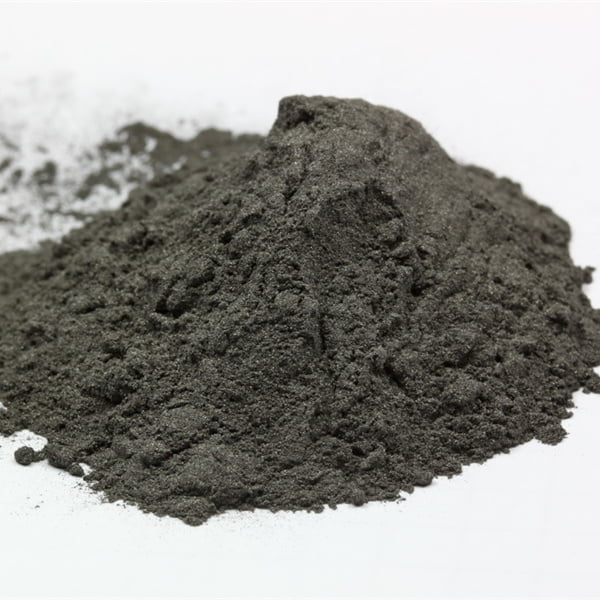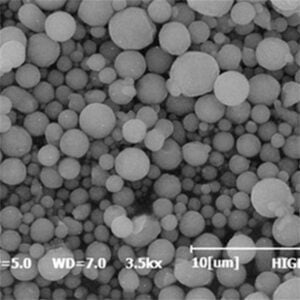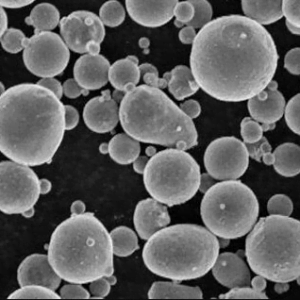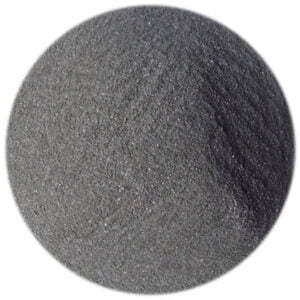Který kovový prášek je vhodný pro Binder Jetting
Obsah
Tryskání pojiva, revoluční technika 3D tisku, otevřela novou kapitolu v aditivní výrobě kovů. Ale stejně jako dokonale uvařený šálek kávy spoléhá na správná zrna, i úspěšné tryskání pojiva závisí na ideálním kovovém prášku. Takže, který kovový magický prach bere dort? Připoutejte se, protože se noříme hluboko do světa kovových prášků pro tryskání pojiva, zkoumáme jejich vlastnosti, aplikace a klíčové hráče v této fascinující aréně.
Charakteristika těchto kovových prášků
Představte si drobné, kulovité kovové částice – to je základní stavební kámen pojivových tryskacích prášků. Ale to nejsou vaše průměrné třpytky. Zde je to, čím jsou výjimečné:
- Velikost a distribuce částic: Představte si to jako stavění z Lega. Jemnější, rovnoměrnější částice (typicky mezi 10 a 50 mikrony) vytvářejí hladší povrchy a těsnější balení, což vede k vynikající kvalitě konečného dílu.
- Morfologie: Na tvaru těchto částic záleží. Kulovité tvary se lépe rozlévají a umožňují rovnoměrné nanášení během tisku.
- Chemické složení: To určuje konečné vlastnosti tištěného dílu. Mezi běžné možnosti patří nerezová ocel, slitiny niklu a nástrojové oceli, z nichž každá nabízí jedinečné výhody.
- Spékavost: Představte si, že se tyto kovové částice drží za ruce poté, co pojivo shoří. Prášky s dobrou slinovatelností se během fáze slinování snadno spojují a dosahují vysoké konečné hustoty.
- Tekutost: Stejně jako sypání písku musí tyto prášky volně proudit, aby se během tisku vytvořila konzistentní vrstva.

Zde je praktická tabulka shrnující tyto klíčové vlastnosti:
| Charakteristický | Popis | Význam v Binder Jetting |
|---|---|---|
| Velikost a distribuce částic | Jemnost a rovnoměrnost kovových částic | Ovlivňuje povrchovou úpravu, hustotu a mechanické vlastnosti finálního dílu |
| Morfologie | Tvar kovových částic | Kulovité tvary zlepšují tekutost a hustotu balení |
| Chemické složení | Prvky přítomné v kovovém prášku | Určuje konečné vlastnosti, jako je pevnost, odolnost proti korozi a tepelné chování |
| Spékavost | Schopnost částic prášku vázat se během slinování | Rozhodující pro dosažení vysoké hustoty a mechanické pevnosti ve finální části |
| Tekutost | Snadnost, s jakou prášek teče | Nezbytné pro konzistentní tvorbu vrstvy během tisku |
Běžně používané kovové prášky pro Tryskání pojiva
Nyní se seznámíme s některými z nejoblíbenějších kovových prášků používaných při tryskání pojiva, z nichž každý má své vlastní silné stránky a aplikace:
1. Nerezová ocel 316L:
Šampion ve všestrannosti, prášek z nerezové oceli 316L kraluje v pojivovém tryskání. Je proslulý svou vynikající odolností proti korozi, pevností a biokompatibilitou a je ideální pro aplikace od lékařských implantátů po letecké komponenty.
2. 17-4PH Nerezová ocel:
Tento vysoce pevný prášek z nerezové oceli se může pochlubit výjimečnými mechanickými vlastnostmi. Myslete na náročné aplikace, jako jsou ozubená kola, hřídele a další součásti vyžadující vynikající pevnost a odolnost proti opotřebení. Ve srovnání s 316L nabízí o něco menší odolnost proti korozi, ale jeho vynikající pevnost z něj činí přesvědčivou volbu pro specifické potřeby.
3. Inconel 625:
Volání všech hrdinů vysokých teplot! Prášek Inconel 625 září v prostředí, kde je teplo. Tato nikl-chromová superslitina odolává extrémním teplotám a vykazuje vynikající odolnost proti oxidaci a korozi. Představte si součásti nebo součásti proudového motoru vystavené agresivním chemikáliím – to je místo, kde se Inconelu 625 daří.
4. Maraging Steel:
Pokud jde o houževnatost, prášek z vysokopevnostní oceli je skvělý. Nabízí jedinečnou kombinaci vysoké pevnosti a dobré tažnosti (schopnost ohýbat se bez zlomení) a je cenným hráčem pro aplikace, jako jsou nástroje a konstrukční součásti.
5. Měď:
Hledáte vodivé šampiony? Do ringu vstoupí měděný prášek. Díky výjimečné tepelné a elektrické vodivosti je ideální pro chladiče, elektrické komponenty a aplikace vyžadující účinný odvod tepla. Ve srovnání s jinými možnostmi může měděný prášek vyžadovat specifické složení pojiva kvůli jeho jedinečným vlastnostem.
6. Titan:
Lehký, ale překvapivě pevný titanový prášek je oblíbený pro letecké a biomedicínské aplikace. Nabízí dobrou rovnováhu mezi pevností, úsporou hmotnosti a biokompatibilitou a dobře se hodí pro komponenty, kde záleží na hmotnosti i výkonu.
7. Slitiny niklu:
Rozmanitá rodina slitin niklu nabízí řadu vlastností v závislosti na jejich specifickém složení. Od odolnosti Inconelu za vysokých teplot po odolnost Hastelloy proti korozi, tyto prášky uspokojují speciální potřeby v náročných prostředích.
8. Nástrojové oceli:
Potřebujete prášek, který dá pořádně zabrat? Prášky nástrojové oceli mají výjimečnou odolnost proti opotřebení a tvrdost.
na Aplikace těchto kovových prášků
Nyní, když jsme se setkali s hvězdami show, podívejme se, jak se tyto kovové prášky promítají do aplikací v reálném světě:
| Kovový prášek | Běžné aplikace | Klíčové úvahy |
|---|---|---|
| Nerezová ocel 316L | Lékařské implantáty, letecké komponenty, šperky, komponenty pro manipulaci s tekutinami | Vynikající odolnost proti korozi, biokompatibilita, dobrá pevnost |
| Nerezová ocel 17-4PH | Ozubená kola, hřídele, ložiska, konstrukční prvky | Vysoká pevnost, odolnost proti opotřebení |
| Inconel 625 | Součásti proudových motorů, zařízení pro chemické zpracování, výměníky tepla | Odolnost proti vysokým teplotám, odolnost proti oxidaci, odolnost proti korozi |
| Maraging Steel | Nástroje, konstrukční prvky | Vysoká pevnost, dobrá tažnost |
| Měď | Chladiče, elektrické komponenty, vlnovody | Vynikající tepelná a elektrická vodivost |
| Titan | Letecké komponenty, biomedicínské implantáty, sportovní zboží | Lehký, dobrá pevnost, biokompatibilita |
| Slitiny niklu | Zařízení pro chemické zpracování, námořní komponenty, výměníky tepla | Vlastnosti šité na míru na základě specifického složení slitiny |
| Nástrojové oceli | Řezné nástroje, raznice, formy | Výjimečná odolnost proti opotřebení, tvrdost |
Beyond the A-List: Zkoumání dalších kovových prášků
Svět kovových prášků pro tryskání pojiva se neustále rozšiřuje. Zde je několik dalších možností, jak získat trakci:
- Hliníkové slitiny: Hliníkové slitiny, které nabízejí lehkou alternativu s dobrou pevností a odolností proti korozi, jsou zkoumány pro aplikace v automobilovém a leteckém průmyslu.
- Žáruvzdorné kovy: Pro ty, kteří se pouštějí do skutečně extrémních prostředí, žáruvzdorné kovy jako wolfram a molybden vydrží neuvěřitelně vysoké teploty, díky čemuž jsou ideální pro aplikace, jako jsou součásti pecí a trysky raket. Tyto prášky však mohou být náročnější na zpracování kvůli jejich vysokým teplotám tání.
- Kovové kompozity: Inovace se připravuje s průzkumem kovových kompozitních prášků. Ty kombinují kovové částice s jinými materiály, jako je keramika nebo polymery, a nabízejí jedinečné kombinace vlastností, jako je zlepšená odolnost proti opotřebení nebo samomazné vlastnosti.
Výběr správného kovového prášku pro tryskání pojiva
Výběr ideálního kovového prášku pro váš projekt tryskání pojiva vyžaduje pečlivé zvážení několika faktorů. Zde je rozpis klíčových specifikací, které je třeba mít na paměti:
| Specifikace | Popis | Důležitost |
|---|---|---|
| Velikost a distribuce částic | Jak bylo uvedeno výše, jemnější a jednotnější částice vedou k lepší povrchové úpravě a hustotě. | |
| Chemické složení | Konkrétní prvky obsažené v prášku určují konečné vlastnosti tištěného dílu. | |
| Tekutost | Pro konzistentní tvorbu vrstvy během tisku musí prášek volně proudit. | |
| Zdánlivá hustota | To se týká hustoty prášku v jeho volné formě. | Ovlivňuje manipulaci s práškem a požadavky na skladování. |
| Hustota poklepání | Toto je hustota prášku po oklepání pro odstranění vzduchových kapes. | |
| Minimální množství objednávky (MOQ) | Minimální množství prášku, které můžete zakoupit od dodavatele. |
Cenovka: Zkoumání nákladů a dodavatelů
Náklady na kovový prášek pro tryskání pojiva se mohou výrazně lišit v závislosti na konkrétním materiálu, velikosti částic a dodavateli. Zde je řada ballpark pro některé oblíbené možnosti:
| Kovový prášek | Cenové rozpětí (za kg) |
|---|---|
| Nerezová ocel 316L | $50 – $100 |
| Nerezová ocel 17-4PH | $70 – $120 |
| Inconel 625 | $150 – $250 |
| Maraging Steel | $100 – $150 |
| Měď | $30 – $50 |
| Titan | $200 – $300 |
Výhody a nevýhody tryskání pojiva
Jako každý materiál, i kovové prášky pro tryskání pojiva mají své vlastní výhody a omezení. Zde je vyvážený pohled, který vám pomůže učinit informované rozhodnutí:
Klady:
- Svoboda designu: Tryskání pojiva umožňuje vytváření složitých geometrií, které mohou být obtížné nebo nemožné tradičními výrobními technikami.
- Materiálová rozmanitost: K dispozici je široká škála kovových prášků, které splňují různé potřeby aplikací.
- Lehké díly: Kovové prášky, jako je hliník a titan, umožňují vytváření lehkých součástí, které jsou klíčové pro průmyslová odvětví, jako je letecký průmysl.
- Hromadné přizpůsobení: Tryskání pojiva je vhodné pro výrobu malých sérií nebo dokonce jednorázových zakázkových dílů.
Nevýhody:
- Náklady na materiál: Kovové prášky mohou být drahé ve srovnání s některými konvenčními materiály.
- Povrchová úprava: Části tryskající pojivem mohou vyžadovat následné zpracování pro hladký povrch.
- Hustota součásti: I když slinování zlepšuje hustotu, nemusí dosáhnout stejné úrovně jako některé jiné techniky zpracování kovů, jako je kování.
- Omezená rychlost výroby: Tryskání pojiva může být pomalejší než některé tradiční výrobní metody pro velkoobjemovou výrobu.

Výběr správného prášku
Jak tedy vyberete ideální kovový prášek pro váš projekt tryskání pojiva? Zde je plán, který vás provede:
- Identifikujte požadavky své aplikace: Zvažte faktory, jako je funkce součásti, potřebné mechanické vlastnosti (pevnost, odolnost proti opotřebení atd.) a podmínky prostředí, s nimiž se setká.
- Prozkoumejte kompatibilní materiály: Prozkoumejte dostupné kovové prášky a jejich vlastnosti podle potřeb vaší aplikace. Chcete-li zúžit své možnosti, podívejte se na informace a tabulky uvedené výše.
- Poraďte se s dodavatelem materiálu: Dodavatelé materiálů mohou nabídnout cenné poznatky a doporučení na základě vašich konkrétních požadavků projektu. Mohou také poradit ohledně faktorů, jako je tekutost prášku a kompatibilita s vaším tryskání pojiva systém.
- Zvažte prototypování: Pokud si nejste jisti nejlepší volbou prášku, zvažte vytvoření prototypů s různými možnostmi pro vyhodnocení potisknutelnosti, vlastností finálního dílu a celkové vhodnosti pro vaši aplikaci.
FAQ
Otázka: Jaké jsou některé faktory, které ovlivňují tekutost kovového prášku?
Odpověď: Velikost částic, tvar a povrchové vlastnosti ovlivňují tekutost. Jemnější prášky a nepravidelné tvary mohou vést k problémům s tekutostí. Dodavatelé často nabízejí prášky se zlepšenými tokovými vlastnostmi pro aplikace tryskáním pojiva.
Otázka: Mohu použít recyklovaný kovový prášek při tryskání pojiva?
Odpověď: Proveditelnost použití recyklovaného kovového prášku závisí na konkrétní aplikaci a procesu recyklace. Recyklované prášky mohou vyžadovat další zpracování, aby byla zajištěna stálá kvalita a potiskovatelnost. Vhodnost recyklovaných prášků pro váš projekt je vhodné konzultovat s dodavatelem materiálu.
Otázka: Jak se skladují kovové prášky?
A: Kovové prášky jsou typicky hygroskopické, což znamená, že absorbují vlhkost ze vzduchu. Proto je třeba je skladovat v prostředí s řízenou vlhkostí, aby se zabránilo oxidaci a zajistil se konzistentní výkon během tisku.
Sdílet na
MET3DP Technology Co., LTD je předním poskytovatelem řešení aditivní výroby se sídlem v Qingdao v Číně. Naše společnost se specializuje na zařízení pro 3D tisk a vysoce výkonné kovové prášky pro průmyslové aplikace.
Dotaz k získání nejlepší ceny a přizpůsobeného řešení pro vaše podnikání!
Související články

Vysoce výkonné segmenty lopatek trysek: Revoluce v účinnosti turbín díky 3D tisku z kovu
Přečtěte si více "O Met3DP
Nedávná aktualizace
Náš produkt
KONTAKTUJTE NÁS
Nějaké otázky? Pošlete nám zprávu hned teď! Po obdržení vaší zprávy obsloužíme vaši žádost s celým týmem.

Kovové prášky pro 3D tisk a aditivní výrobu
SPOLEČNOST
PRODUKT
kontaktní informace
- Město Qingdao, Shandong, Čína
- [email protected]
- [email protected]
- +86 19116340731
















